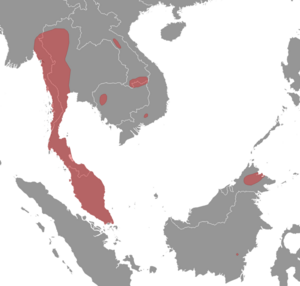Blanford's bat facts for kids
Quick facts for kids Blanford's bat |
|
|---|---|
| Conservation status | |
| Scientific classification | |
| Genus: |
Hesperoptenus
|
| Species: |
blanfordi
|
 |
|
Blanford's bat (Hesperoptenus blanfordi) is a small type of vesper bat. These bats are found in countries like Brunei, Cambodia, Indonesia, Laos, Malaysia, Myanmar, and Thailand. They live in many different kinds of forests. The International Union for Conservation of Nature says that Blanford's bat is a "least concern" animal. This means it is not currently in danger of disappearing.
Contents
Discovering Blanford's Bat
Blanford's bat was first described in 1877 by a scientist named George Edward Dobson. He was an Irish zoologist and also worked as an army surgeon in India. Dobson was an expert on small mammals, especially bats.
He gave the bat its scientific name, Hesperoptenus blanfordi. This name was chosen to honor another British scientist, William Thomas Blanford. Blanford was a geologist and zoologist who studied animals in India.
What Does Blanford's Bat Look Like?
Blanford's bat is a small bat with a strong body. Its forearm, which is part of its wing, is about 24 to 29 millimeters (about 1 inch) long.
This bat has a pointed head. Its fur is dark brown, smooth, and looks shiny. It also has a special pad of thick, dark skin at the base of its thumb.
Where Do These Bats Live?
Blanford's bat lives in mainland Southeast Asia and on the island of Borneo. You can find them in eastern Myanmar, Thailand, and Peninsular Malaysia. They are also present in parts of Cambodia, Laos, and Vietnam. Some have even been seen in eastern Borneo.
These bats are not very common. They prefer to live in different types of forests, such as:
- Lowland humid forests (wet forests near sea level)
- Dryer dipterocarp forests (forests with specific types of trees)
- Hill forests
- Limestone caves
They often live near streams and small rivers. Blanford's bats usually live in small groups, with up to ten bats in one colony.
Is Blanford's Bat Safe?
Blanford's bat lives across a wide area. Scientists believe there are a good number of them in total. We don't know if their population is growing or shrinking, but there are no major threats to these bats right now. They seem to be able to live in many different types of places.
These bats are found in several protected areas, which helps keep them safe. Because of this, the International Union for Conservation of Nature has decided that Blanford's bat is a "least concern" species. This means they are not currently at high risk of extinction.


